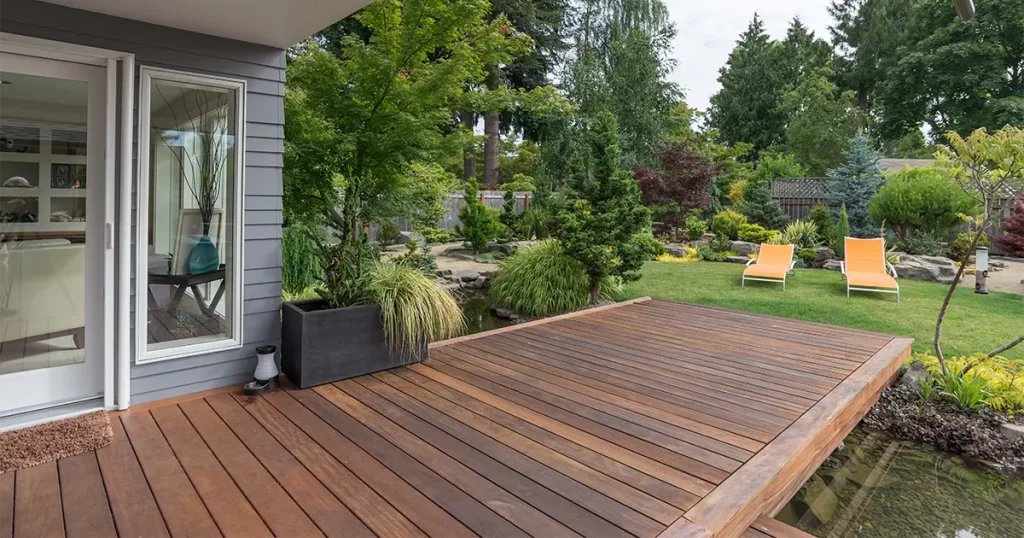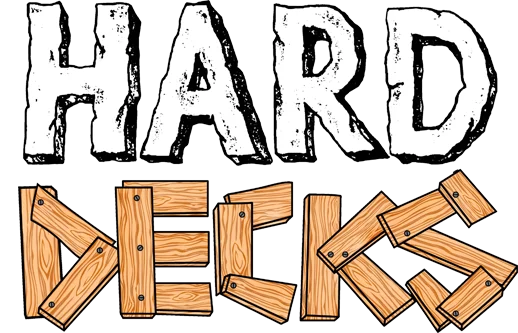
Take Your Backyard From Lawn to Lounge
Thinking about building a floating deck but not sure where to start? Wondering how to make yours stand out from the basic square-on-grass setup?
In this post, you’ll find a full breakdown of floating deck ideas from layout styles and built-in features to smart upgrades that make your space feel custom.
By the end, you’ll have a list of design options to help your deck installation fit your yard, your style, and your budget.
What Are 15 Great Floating Deck Ideas?
- Tiny Lounge Decks
- Multi-Level Decks
- Deck Islands
- Side-Yard Decks
- Dining Decks
- Corner Decks
- Decks With Pergolas
- Garden-Integrated Decks
- Rug-Layered Decks
- Decks With Built-In Seating
- Decks With Planter Boxes
- Minimalist Floating Platforms
- LED-Lit Decks
- Corner-Entry Decks
- Decks With Water or Fire Features
Contact us today about your deck installation.
15 Floating Deck Ideas You’ll Want to Have Right Now
1. Tiny Lounge Decks
A small, square floating deck can turn almost any patch of your yard into a hangout zone.
These simple deck builds are great if you’re short on space but still want room for a couple of chairs and a table.
Keep it ground level and use deck blocks to lift the frame just a few inches off the ground for airflow and stability. Add some outdoor furniture or a rug for a cozy touch, and you’ve got an easy weekend project that pays off big.
2. Multi-Level Decks
Layering your floating deck setup adds depth and purpose.
One platform could hold a dining space while another creates a lounge area nearby. The design works well on sloped yards, helping you avoid digging into the ground or messing with the frost line.
Just make sure your joists and deck frame are level and well supported between each tier.
3. Deck Islands
Instead of one large square, build a few smaller platforms separated by paver base walkways or gravel.
These floating deck ideas feel playful and intentional—great for large, landscaped backyards. Each platform can serve its own function, like sitting, sunbathing, or even yoga.
4. Side-Yard Decks
Don’t overlook the long, narrow space running beside your house or fence.
This is prime real estate for a ground-level floating deck. Keep the structure tight and sleek using clean deck boards and minimal edging. It’s a great option if your main backyard area is already in use, but you still want a quiet sitting space.
5. Dining Decks
Whether it’s your first deck or your fifth, designing one for eating outside is always a win.
Build a floating deck just big enough to hold a table and chairs, and place it near your kitchen door for easy food runs.
Use composite decking for easy cleanup after meals and to avoid food stains.
A pergola or umbrella adds shade without needing to attach anything to your house.
6. Corner Decks
Use one corner of your backyard to tuck in a small floating deck.
Surrounded by landscaping or a garden bed, this kind of build turns dead space into a reading or relaxing nook.
For privacy, add a trellis or low screen on one side.
If the corner slopes, you might only need a few extra deck blocks to level things out.
7. Decks With Pergolas
A pergola adds height, shade, and structure.
If you’re going for a more polished look, this is one of the best floating deck ideas to try. Keep the floating illusion intact by setting your pergola posts through the deck surface and securing them with concrete footings beneath.
Pair with climbing plants or string lights to complete the vibe.
8. Garden-Integrated Decks
Let the deck fade into the yard by planting around the edge.
Ornamental grasses, herbs, or even a mix of wildflowers will soften the transition between the decking material and the surrounding area. You can build a floating deck with curved lines or notched corners to let plants hug the frame naturally.
9. Rug-Layered Decks
An outdoor rug does more than add style.
It protects your deck boards, makes the space feel like a living room, and adds comfort under bare feet.
Choose a neutral rug to let your plants and furniture pop, or go bold to make the deck the centerpiece.
10. Decks With Built-In Seating
Instead of squeezing in bulky outdoor furniture, design your deck frame with benches built into the edge. It opens up more usable space, especially on smaller square decks.
You can even build in storage underneath the seating if you’re up for an extra step.
More ideas for built-in deck benches.
11. Decks With Planter Boxes
Planters at the corners or along the perimeter help define your floating deck and bring a burst of color to the wood. Use them to grow herbs, flowers, or tall grasses that double as privacy.
Raised beds built right into the deck frame keep things clean and intentional.
12. Minimalist Floating Platforms
These floating decks rely on clean lines, low profiles, and modern decking material like composite or light-stained cedar. Try recessed joist hangers and fascia boards to hide hardware and keep things smooth.
They’re great in contemporary homes or outdoor spaces with sleek hardscaping.
13. LED-Lit Decks
For nighttime use, wrap LED strips around the outer edge of your floating deck.
The lights highlight the perimeter, make the deck look like it’s hovering, and keep the area safe after sunset. If you’re wiring lights yourself, be sure to pre-drill through joists and keep everything watertight.
14. Corner-Entry Decks
Instead of a centered staircase or side-step layout, angle the entrance from a corner. It creates a unique path and works well for decks that sit off-center in the yard.
Add a curved garden path leading to the deck to pull everything together.
15. Decks With Water or Fire Features
Whether it’s a sunken fire pit or a shallow fountain, these extras make your deck feel like a destination.
Choose materials that can handle heat or moisture, and be sure to direct rainwater away from the frame with proper spacing and drainage beneath.
Set the feature as a focal point, or tuck it into a quiet backyard corner.
Other deck design ideas and tips.
What to Know About Floating Decks
Floating decks are usually built just a few inches off the ground, resting on deck blocks or a paver base, not buried footings. They don’t require attachment to the house, which means fewer permits and faster builds.
Gravel and landscape fabric underneath help with drainage and weed control. Composite decking and fascia boards can reduce maintenance while keeping things sharp and polished.
If you’re going to build a floating deck yourself, plan your joists and deck frame carefully, and always check local building codes first.
Go From Flat Ground to Floating Perfection with Hard Decks
If you want a floating deck that fits your style and your space, Hard Decks can help. We design and install custom decks all over northeastern Illinois, whether you’re starting with a blank yard or upgrading your current setup.
Ready to turn your ideas into something solid? Fill out our contact form today or give us a call.
